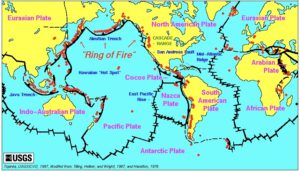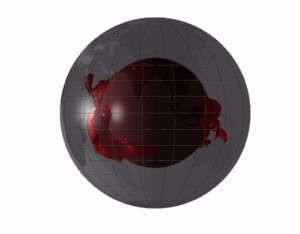
Did you know that there are big, blob-like anomalies in the deep mantle which are larger than a continent and rise up to hundreds of kilometers from the core-mantle boundary? Today’s post is all about those blobs and what we know and do not know about them. If you want to know more about why these blobs are so interesting to study, check out this other cool blog post by Jamie Ward.
If you look at any map presenting the distribution of volcanoes in our planet (Figure 1), you will quickly notice that most of the volcanism occurs near the boundaries of tectonic plates, where one of them subducts beneath the other or where two plates spread apart to form new crust. However, there is also a third, less-intuitional kind of volcanism present within the plates themselves. The Hawaiian Islands are typical examples of intraplate, hotspot volcanism originating from plumes in the mantle. Mantle plumes are hot, buoyant rocks rising upwards through the mantle and are regarded to be associated with the large, low velocity features present in the lowermost mantle, known as the Large Low Shear Velocity Provinces or LLSVPs (Garnero et al., 2016).
Figure 1 Global distribution of volcanism with respect to plate boundaries (Credit: USGS)
Since the early attempts at imaging the interior of the Earth using seismic wave velocities (i.e., global seismic tomographies), seismologists have observed two very large, low shear velocity anomalies in the lowermost mantle beneath Africa and the central Pacific region (Figure 2). Lower shear velocities represent hotter material as the ability to resist shear deformation decreases with increasing temperature. These LLSVPs, also called superplumes, have been nicknamed Tuzo (beneath Africa) and Jason (beneath the Pacific), after two prominent contributors to the concept of mantle plumes. The association of mantle plumes and hotspots with LLSVPs is an argument supported by the distribution of current as well as paleo-surface expressions of hotspots being concentrated right above where LLSVPs are situated (McNamara, 2019).
Figure 2 Large Low Shear Velocity Provinces (LLSVPs) (Credit: Wikimedia; original work by Sanne Cottaar, CC BY-SA 4.0, https://commons.wikimedia.org/w/index.php?curid=64665106)
Even though evidence from several different scientific techniques have established that LLSVPs exist (eg. Lekic et al., 2012; Garnero et al., 2016), we still do not know a lot about how they were formed, what they are made of, and how stable they are (McNamara, 2019). As LLSVPs represent extensive heterogeneities in the mantle, knowing more about their nature is important to improve our understanding of global mantle convection and consequently plate tectonics.
Origin of LLSVPs
The hypotheses proposed regarding the origin of LLSVPs range from LLSVPs being remnants from the primordial stages of our planet’s history to them being megaplumes rising upwards from the lowermost mantle (see review by McNamara, 2019). The straightforward assumption of LLSVPs as megaplumes is difficult to believe as megaplumes are expected to be narrow, unlike what we observe LLSVPs to be (see McNamara, 2019). LLSVPs might be a collection of smaller plumes, which appear more blobby because of the limitations of tomography (Schubert et al., 2004). Another popular view is that LLSVPs are dense primordial material that have sunk to the basal part of the mantle (Tackley, 2012). LLSVPs are also explained as graveyards of oceanic crust (Niu, 2018). Although LLSVPs most likely play an important role in the plate tectonic framework, we are still not sure about what might have caused them to form.
Are LLSVPs thermal or compositional heterogeneities?
LLSVPs have been observed to have sharp changes in shear velocities along their boundaries, favoring the possibility of them being compositional heterogeneities (He & Wen, 2012). The anti-correlation of shear wave speed and bulk sound speed in the LLSVPs indicates compositional heterogeneity or a change in the phase (Koelemeijer et al., 2016). Although thermal contribution cannot be entirely ruled out, most observations support LLSVPs being chemical anomalies, suggesting a thermochemical nature (McNamara, 2019).
Are LLSVPs denser or more buoyant than the surrounding mantle?
LLSVPs are normally thought to be hotter and denser than the surrounding mantle (Lau et al., 2017). Even though investigations using normal mode observations suggest that LLSVPs might be more buoyant than the adjacent mantle material, it still does not rule out the possibility of the basal portion of LLSVPs being denser and therefore, points to a complex density distribution within the LLSVPs (Koelemeijer et al., 2017; McNamara, 2019).
In addition to global mantle convection, the antipodal position of LLSVPs (i.e., their locations on opposite sides of the Earth) might have implications on the axial rotation of our planet (Niu, 2018). Learning more about LLSVPs will be useful to understand the different ways our planet functions.
References: Garnero, E. J., McNamara, A. K., & Shim, S.-H. (2016). Continent-sized anomalous zones with low seismic velocity at the base of Earth’s mantle. Nature Geoscience, 9(7), 481–489. https://doi.org/10.1038/ngeo2733 He, Y., & Wen, L. (2012). Geographic boundary of the “Pacific Anomaly” and its geometry and transitional structure in the north: STRUCTURE OF THE PACIFIC ANOMALY. Journal of Geophysical Research: Solid Earth, 117(B9). https://doi.org/10.1029/2012JB009436 Koelemeijer, P., Deuss, A., & Ritsema, J. (2017). Density structure of Earth’s lowermost mantle from Stoneley mode splitting observations. Nature Communications, 8(1), 15241. https://doi.org/10.1038/ncomms15241 Koelemeijer, P., Ritsema, J., Deuss, A., & van Heijst, H.-J. (2016). SP12RTS: A degree-12 model of shear- and compressional-wave velocity for Earth’s mantle. Geophysical Journal International, 204(2), 1024–1039. https://doi.org/10.1093/gji/ggv481 Lau, H. C. P., Mitrovica, J. X., Davis, J. L., Tromp, J., Yang, H.-Y., & Al-Attar, D. (2017). Tidal tomography constrains Earth’s deep-mantle buoyancy. Nature, 551(7680), 321–326. https://doi.org/10.1038/nature24452 Lekic, V., Cottaar, S., Dziewonski, A., & Romanowicz, B. (2012). Cluster analysis of global lower mantle tomography: A new class of structure and implications for chemical heterogeneity. Earth and Planetary Science Letters, 357–358, 68–77. https://doi.org/10.1016/j.epsl.2012.09.014 McNamara, A. K. (2019). A review of large low shear velocity provinces and ultra low velocity zones. Tectonophysics, 760, 199–220. https://doi.org/10.1016/j.tecto.2018.04.015 Niu, Y. (2018). Origin of the LLSVPs at the base of the mantle is a consequence of plate tectonics – A petrological and geochemical perspective. Geoscience Frontiers, 9(5), 1265–1278. https://doi.org/10.1016/j.gsf.2018.03.005 Schubert, G., Masters, G., Olson, P., & Tackley, P. (2004). Superplumes or plume clusters? Physics of the Earth and Planetary Interiors, 146(1), 147–162. https://doi.org/10.1016/j.pepi.2003.09.025 Tackley, P. J. (2012). Dynamics and evolution of the deep mantle resulting from thermal, chemical, phase and melting effects. Earth-Science Reviews, 110(1), 1–25. https://doi.org/10.1016/j.earscirev.2011.10.001






